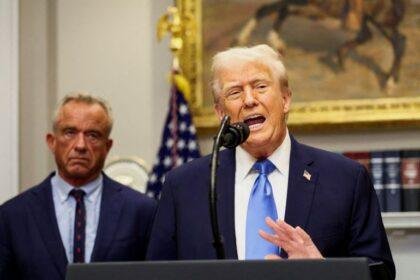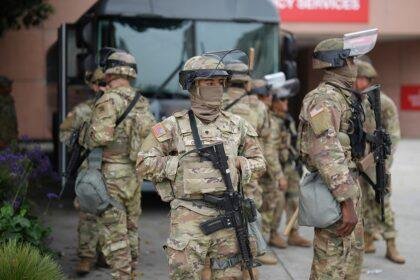Pro-Hamas Graffiti Sparks Outrage in Melbourne
In a troubling incident that has ignited public outrage, Deputy Prime Minister Richard Marles condemned pro-Hamas graffiti found on a billboard in Fitzroy, a suburb of Melbourne. The graffiti, which read “Glory to Hamas,” has drawn sharp criticism from various political leaders and community members, particularly given the date’s significance in relation to a tragic event in recent history.
A Day of Remembrance
Marles emphasized the gravity of the situation, noting that the graffiti appeared on the anniversary of a terrorist attack that claimed the lives of over 1,200 innocent people two years ago. Speaking on ABC Radio Melbourne, he described the day as one of “commemoration and remembrance,” underscoring the insensitivity of the graffiti’s message. “It’s disgraceful,” he stated, highlighting the need for a cohesive society that stands against divisive messages.
The Deputy Prime Minister’s remarks reflect a broader sentiment in Australia, where public displays of support for organizations like Hamas, which is classified as a terrorist group, are met with significant backlash. Marles expressed uncertainty about whether the graffiti could be classified as a terrorism offense but assured that authorities would investigate the matter thoroughly.
Political Reactions
Sussan Ley, the opposition leader, also weighed in on the issue, labeling the graffiti as “deeply disturbing.” Ley called for those responsible to face the “full force of the law,” emphasizing that supporting Hamas is not a matter of free speech but rather a criminal act in Australia. “Victorians deserve to feel safe in their own community,” she asserted, urging law enforcement agencies to take swift action against the perpetrators.
Ley’s comments echo a growing concern among Australian lawmakers regarding the rise of extremist ideologies and the potential for such expressions to incite further division within society. The Australian Federal Police (AFP) and the Australian Security Intelligence Organisation (ASIO) have been urged to collaborate with local police to track down those responsible for the graffiti.
Historical Context
The incident is not isolated; it reflects a broader trend of rising tensions surrounding the Israeli-Palestinian conflict, which has seen a resurgence in public discourse and activism in recent years. The conflict’s historical roots date back to the early 20th century, with both sides claiming historical and cultural ties to the land. The emergence of groups like Hamas, founded in 1987, has further complicated the situation, leading to cycles of violence and retaliation.
In Australia, the public’s response to such incidents often mirrors global sentiments, with protests and counter-protests becoming increasingly common. The graffiti in Fitzroy serves as a stark reminder of the challenges faced by multicultural societies in navigating complex geopolitical issues while maintaining social harmony.
Community Impact
The graffiti incident has sparked discussions within the Fitzroy community and beyond about the implications of such messages on local cohesion. Community leaders have expressed concern that displays of support for terrorist organizations can alienate members of the community and foster an environment of fear and division.
Local residents have taken to social media to voice their outrage, with many calling for a united front against hate speech and extremism. The incident has prompted calls for educational initiatives aimed at fostering understanding and dialogue among diverse community groups.
Conclusion
The pro-Hamas graffiti in Fitzroy has not only drawn condemnation from political leaders but has also ignited a broader conversation about the implications of such expressions in a multicultural society. As Australia grapples with the complexities of global conflicts and their local manifestations, the need for unity and understanding becomes increasingly vital. The incident serves as a reminder of the importance of fostering a cohesive society that stands against hate and division, particularly in times of remembrance and reflection.
Environment Minister Engages Stakeholders Ahead of Major Legislative Changes
Murray Watt’s Consultative Approach to Environmental Legislation
In a proactive move to reshape Australia’s environmental policies, Environment Minister Murray Watt has engaged in extensive consultations with various stakeholders since assuming his role in May. Over the past few months, Watt has held 73 meetings with key players, including environmental organizations and major corporations, as he prepares to introduce significant legislative changes aimed at enhancing environmental protections while expediting project approvals.
A New Era of Consultation
Watt’s commitment to dialogue marks a notable shift from the previous administration under Tanya Plibersek, who faced criticism for a perceived lack of engagement with stakeholders. In a recent statement, Watt emphasized the importance of collaboration, stating, “It is vital that this new legislation is passed with the broadest support possible.” His approach aims to build consensus among diverse groups, including the Australian Conservation Foundation, BHP, Rio Tinto, and the Australian Minerals Council.
The minister has been meeting every Friday with these stakeholders, demonstrating his dedication to understanding their perspectives and incorporating their feedback into the upcoming reforms. This consultative strategy is particularly crucial as the government seeks to balance environmental sustainability with economic growth, a challenge that has historically polarized public opinion.
Legislative Changes on the Horizon
As the year draws to a close, Watt is in the final stages of consultations, gearing up to introduce reworked environmental laws. These changes are expected to focus on three key areas: stronger environmental protections, faster project approvals, and increased transparency in decision-making processes. The urgency of these reforms is underscored by the growing public concern over climate change and biodiversity loss, issues that have gained prominence in recent years.
Historically, Australia has faced significant challenges in reconciling economic development with environmental stewardship. The mining and energy sectors, which are vital to the nation’s economy, have often been at odds with environmental advocacy groups. Watt’s approach seeks to bridge this divide by fostering a collaborative environment where both economic and ecological interests can be addressed.
The Broader Context
The push for reform comes at a time when Australia is under increasing pressure to meet its climate commitments. The country has set ambitious targets for reducing greenhouse gas emissions, and the upcoming legislation is seen as a critical step toward achieving these goals. The government’s ability to navigate the complexities of environmental policy will be closely watched, both domestically and internationally.
In recent years, Australia has faced scrutiny over its environmental policies, particularly in relation to land clearing, water management, and the protection of endangered species. The introduction of new laws that prioritize environmental sustainability could enhance Australia’s reputation on the global stage, particularly as nations grapple with the impacts of climate change.
Conclusion
Murray Watt’s consultative approach to environmental legislation represents a significant shift in Australia’s policy-making landscape. By engaging with a wide range of stakeholders, he aims to create a framework that balances economic growth with environmental protection. As the government prepares to unveil its proposed reforms, the success of these initiatives will depend on the ability to foster collaboration and build consensus among diverse interests. The coming months will be crucial in determining the future of Australia’s environmental policies and their alignment with global sustainability goals.
Commemoration Amidst Controversy: Australia Reflects on October 7 Attacks
As Australia marks the second anniversary of the tragic October 7 attacks, Deputy Prime Minister Richard Marles has called for a day of remembrance rather than protest. His remarks come as pro-Palestinian groups plan demonstrations in major cities, highlighting the ongoing conflict in Gaza. This juxtaposition of commemoration and protest underscores the complex socio-political landscape in Australia and abroad.
A Day of Remembrance
On the morning of October 7, 2025, Marles emphasized the importance of honoring the memory of the 1,200 innocent lives lost in the attacks. Speaking on the morning program Sunrise, he stated, “Today should not be a day of protest. It is a moment to commemorate and remember the more than 1,200 lives that were lost in the appalling terrorist attack on Israel.” His comments reflect a broader sentiment among many Australians who wish to focus on healing and remembrance rather than division.
The October 7 attacks, orchestrated by Hamas, were a watershed moment in global politics, leading to heightened tensions in the Middle East and beyond. The ramifications of that day continue to resonate, influencing international relations and domestic policies.
Protests and Political Tensions
While Marles called for unity in remembrance, pro-Palestinian groups in cities like Melbourne and Sydney are organizing protests to draw attention to the humanitarian crisis in Gaza. These demonstrations are part of a larger movement advocating for Palestinian rights, which has gained momentum in recent years. The ongoing conflict has polarized opinions, with many Australians feeling compelled to voice their concerns about the humanitarian implications of the war.
Marles acknowledged the government’s awareness of the humanitarian catastrophe unfolding in Gaza, stating, “We have loudly called out the humanitarian catastrophe playing out in Gaza.” However, he urged that the focus on this day should remain on the victims of the October 7 attacks, emphasizing the need for a respectful commemoration.
Historical Context
The October 7 attacks are not just a recent tragedy; they are part of a long history of conflict in the region. The Israeli-Palestinian conflict has roots that extend back over a century, characterized by cycles of violence, failed peace negotiations, and deep-seated grievances. The attacks served as a catalyst for renewed military action and international debate over the rights and wrongs of both sides.
In the wake of the attacks, Australia has reaffirmed its commitment to Israel, aligning itself with the United States in its stance against Hamas. Prime Minister Anthony Albanese has called the day “a day of pain and terror for Jewish people around the world,” and has urged for the immediate return of Israeli hostages still held by Hamas.
Political Responses
Albanese’s remarks were echoed by Opposition Leader Sussan Ley, who described the October 7 attacks as “one of the most horrific terrorist attacks in modern history.” Ley criticized the government’s response, arguing that more action is needed to combat rising antisemitism in Australia. She called for the government to “get off the fence” and implement the recommendations of their own antisemitism envoy.
This political back-and-forth highlights the challenges faced by the Australian government in navigating a complex international issue while addressing domestic concerns. The calls for action against antisemitism resonate with many Australians who are increasingly aware of the need for a balanced approach to the Israeli-Palestinian conflict.
The Broader Implications
The events of October 7, 2023, and the subsequent political discourse have broader implications for Australia’s foreign policy. The nation’s historical ties to Israel and its strategic partnerships in the Asia-Pacific region are being scrutinized as geopolitical tensions rise, particularly concerning China. The recent signing of the Pukpuk Treaty with Papua New Guinea, which includes mutual defense provisions, reflects Australia’s efforts to bolster its security alliances in a rapidly changing geopolitical landscape.
Marles has described the treaty as a “natural expression” of the relationship between Australia and Papua New Guinea, emphasizing the importance of regional partnerships. However, the treaty also raises questions about Australia’s role in potential conflicts involving China, with Papua New Guinea’s Prime Minister James Marape suggesting that his country may choose to remain neutral in such scenarios.
Conclusion
As Australia reflects on the tragic events of October 7, 2023, the nation finds itself at a crossroads. The call for remembrance by leaders like Richard Marles serves as a reminder of the human cost of conflict, while the planned protests highlight the ongoing struggles for justice and humanitarian rights. The interplay between commemoration and activism underscores the complexities of a nation grappling with its identity and values in a global context. As the political landscape evolves, the challenge remains for Australia to navigate these turbulent waters with empathy and resolve.











